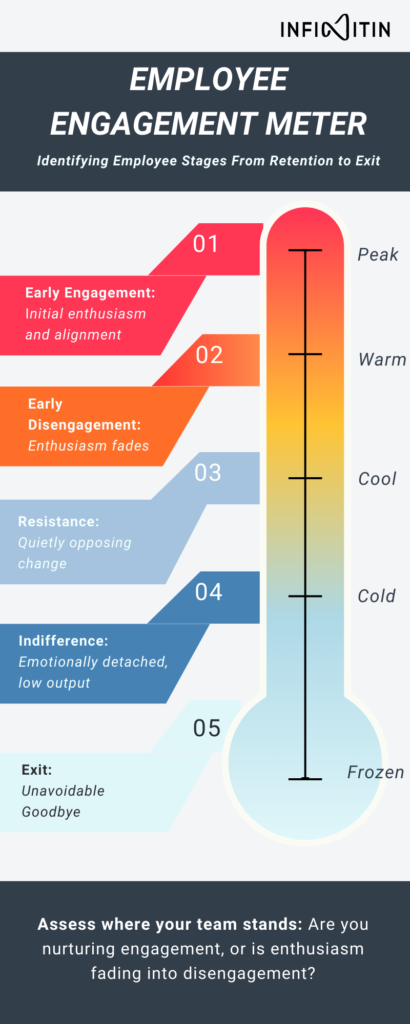Employee disengagement doesn’t happen overnight; it’s a gradual decline that can quietly undermine your organization’s success. It costs the US and Canada up to $550 billion annually and can increase turnover by up to 59%. Imagine the silent, creeping erosion of enthusiasm that leads to turnover and lost potential. To prevent this, understanding the five stages of disengagement and acting early can be the difference between a thriving team and a revolving door of talent.
Stages of Employee Disengagement

1. Engagement: The Exciting Beginning Think back to when your employees first joined—brimming with excitement, eager to contribute, and fully aligned with your mission. This initial burst of engagement is like a spark that fuels innovation and commitment. However, this spark needs nurturing. Leadership plays a crucial role, as 70% of engagement hinges on your actions. Without continuous support and recognition, that initial enthusiasm can flicker and fade.
Signs: Enthusiasm wanes, participation drops. Actions: Don’t just check in; connect meaningfully. Make sure every employee feels valued and see their roles as part of a bigger vision.
2. Disengagement: The Invisible Drift Disengagement isn’t a collapse—it’s a subtle drift away from passion and purpose. Employees become “just employees,” doing their jobs without the spark that once drove them. This stage is dangerous because it often goes unnoticed until it’s too late.
Signs: Work quality dips, deadlines slip, and initiative dwindles. Actions: Don’t wait for a performance crisis. Start conversations, understand their worries, and reignite their passion with clear feedback and growth opportunities.
3. Resistance: The Quiet Rebellion Resistance is where disengagement starts to make noise. Employees push back against changes, question decisions, and challenge new initiatives. It’s a signal that dissatisfaction is bubbling to the surface.
Signs: Subtle pushbacks, resistance to new processes, vocal complaints. Actions: Involve your team in decision-making. Make them part of the change rather than merely subjects of it. Clear communication and genuine involvement can turn resistance into engagement.
4. Indifference: The Emotional Disconnect Indifference is a dangerous phase where employees are physically present but mentally checked out. They’re no longer just disengaged; they’re emotionally detached. This phase can drag down team morale and productivity.
Signs: Absenteeism rises, effort drops, and involvement in team activities diminishes. Actions: Reconnect with them on a personal level. Offer new challenges and opportunities that align with their career goals. Help them see how their work impacts the company’s mission.
5. Exit: The Unavoidable Goodbye The final stage is exit, where disengagement and indifference culminate in employees leaving. It’s often the result of previous stages being mishandled. The good news? Most exits are preventable.Signs: Increased job search activity, visible dissatisfaction. Actions: Focus on retaining your talent. Implement strategies for career development, work-life balance, and strong leadership support to address signs of disengagement before they lead to exits.
Where Do Your Teams/ Employees Fall?
Take a moment to assess where your team stands on this scale. Are you actively nurturing engagement, or are you watching as enthusiasm fades into disengagement and indifference? Your employees are the driving force behind your growth. If you’re not already addressing these stages effectively, now is the time to start.
It (Employee Disengagement) costs the US and Canada up to $550 billion annually and can increase turnover by up to 59%.
Act Now: Transform Engagement into Success Recognize the stages of disengagement early and take decisive action. Your approach to engagement, resistance, and indifference can transform potential exits into growth opportunities.
- Engage Proactively: Foster a culture where every employee feels integral to the company’s success. Make each interaction count.
- Address Disengagement: Don’t let issues fester. Engage directly, understand deeply, and act swiftly to restore passion.
- Manage Resistance: Turn resistance into collaboration by involving employees in changes and communicating clearly.
- Reignite Purpose: Align roles with personal growth and the company’s mission to combat indifference.
- Prevent Exit: Focus on retention strategies that address core issues and demonstrate genuine commitment to your team’s well-being.
Remember, it’s never too late. People challenges are opportunities in disguise. Actively tackling these issues can drive a 25% increase in productivity and a 20% rise in employee satisfaction, translating into significant cost savings and performance gains (Harvard Business Review, 2023).
By addressing these issues head-on, you can reignite passion, foster loyalty, and drive your organization to new heights. Transform your approach today and watch your team’s potential unfold.
